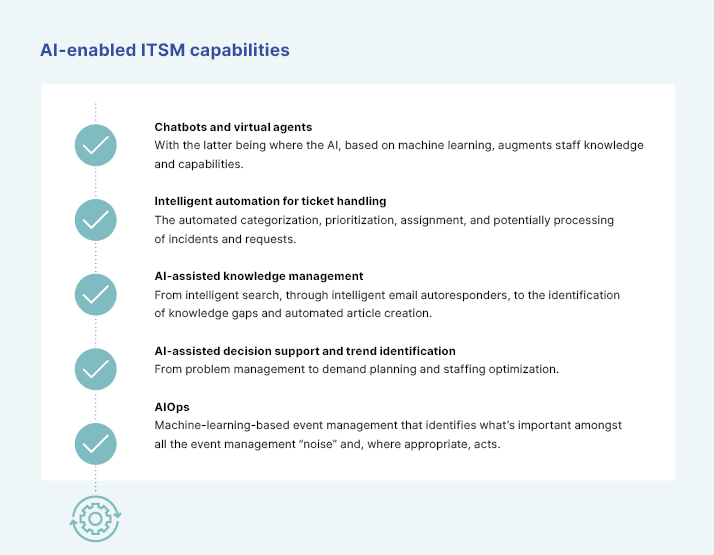Compared to the previous version ITIL v3/2011, ITIL 4 introduces some new, comprehensive concepts and also offers a number of possibilities for improving strategic and operational IT service management. Some functional requirements for IT service management tools can be derived from this. This article explains which important tool functions you need to implement ITIL 4 Practices. It's an excerpt from a comprehensive white paper that USU wrote together with ITIL expert Stephen Mann.
Focus on value contribution and new reporting and analysis requirements
While the use of value steams – rather than ITIL v3/2011 processes – can be catered for through the use of the graphical workflow engines found in most successful ITSM tools, there’s also the need to move from volume- and activity-based metrics – such as “how many” and “how long” – to those that better articulate the positive business outcomes, and the value that’s co-created, to key business stakeholders.
An example of this is minimizing vehicle production delays and losses caused by IT issues for a car manufacturer. Or, for a healthcare provider, increasing the number of patients through digitalized processes. This requirement to refocus metrics, with appropriate tool enablement of performance measurement and reporting, is likely also true for your organization’s need to measure and improve employee experience.
Non-IT ITSM Tool Usage
ITIL 4 is aimed at service management per se rather than just ITSM, with this impacting the needs of ITSM tools from an enterprise service management perspective.
The adoption of enterprise service management – “the use of ITSM principles and capabilities in other business areas to improve performance, service, and outcomes” – has grown significantly in the last five years. And while ITIL 4 doesn’t explicitly talk to enterprise service management, its service management approach will no doubt make ITIL guidance highly applicable to enterprise service management strategies (and back-office digital transformation initiatives).
However, in return they should offer a very good user experience for end users, allow the introduction of new, non-IT data objects (e.g. buildings or furniture) and enable the separation of specific functions, data and knowledge management articles for the individual service areas.
The call for increasing automation
A key ITIL 4 principle is automation. This requires AI-supported ITSM functions (see figure ).

Illustration: AI-supported ITSM functions
The impact on "ITSM tool structures"
The discontinuation of the ITIL lifecycle of ITIL v3/2011 has a significant impact on the tool structures, i.e. on how the various functions of the tools are presented to the user.
ITIL v3/2011 has been used as a “blueprint” for ITSM tool design for over a decade, with all of the service operation capabilities grouped, all the service transition capabilities grouped, and so on. Now that service strategy, service design, service transition, service operation, and continual service improvement are no longer the convenient “homes” for the ITIL processes/practices, it means that a new logical structuring is needed.
So far, there’s no industry-agreed view on this, either from AXELOS or ITSM tool vendors. With it inevitable that ITSM tools will continue to present their ITSM capabilities in line with the ITIL v3/2011 structure for the foreseeable future – until a new solution is agreed upon (based upon which of the new and changed management practices are sufficiently adopted by customers). For example, whether organizational change management capabilities are repeatedly called for by customers, such that it becomes a standard ITSM tool feature set, will ultimately influence how any ITIL-4-based tool structure is created.
"Many of the tool functions required by ITIL 4 are already available in some ITSM tools. But there are also functions that will not be available in the foreseeable future.
Key ITIL 4 practices and new functional requirements
In addition to the concept-based, more general implications, individual practices each require specific ITSM tool functions.
Three of the most important and common processes/practices and their requirements for new tool functions are described below as examples. For the complete list of ITIL 4 Practices and the resulting tool requirements, please refer to the white paper.
Change Enablement
This practice requires DevOps-related capabilities. From integrations to DevOps toolchains to the addition of related capabilities (including increased change automation and orchestration), perhaps even DevOps modules. These features will also likely be requested by IT organizations that do not plan to adopt ITIL 4.
Problem Management
The greater use of automation and machine learning for proactive incident prevention is likely to be the most wanted and beneficial new feature request. ITIL 4 also reintroduced error control and problem control after they were dropped in ITIL v3/2011. If they were ever removed from the more mature ITSM tools they could now return
Service Desk
There are two potential needs for ITSM tools related to the new ITIL 4 service desk practice. One is the use of “query” record/status to reflect something that’s presented by an end user before it’s categorized – it could eventually be an incident, a request, or something else. The other need is for omnichannel support – and this need is not only being driven by the adoption of ITIL 4 guidance, but it’s also a larger market shift. Some ITSM tools will need to add to additional channels and capabilities – for instance, chat and chatbots – to meet this need. Either natively or via technology partners.
As mentioned above, some of the functions required for ITIL 4 may already be supported by your current ITSM tool. However, in order to implement missing functions, tool vendors will align their development plans with the needs of their current and potential customers.